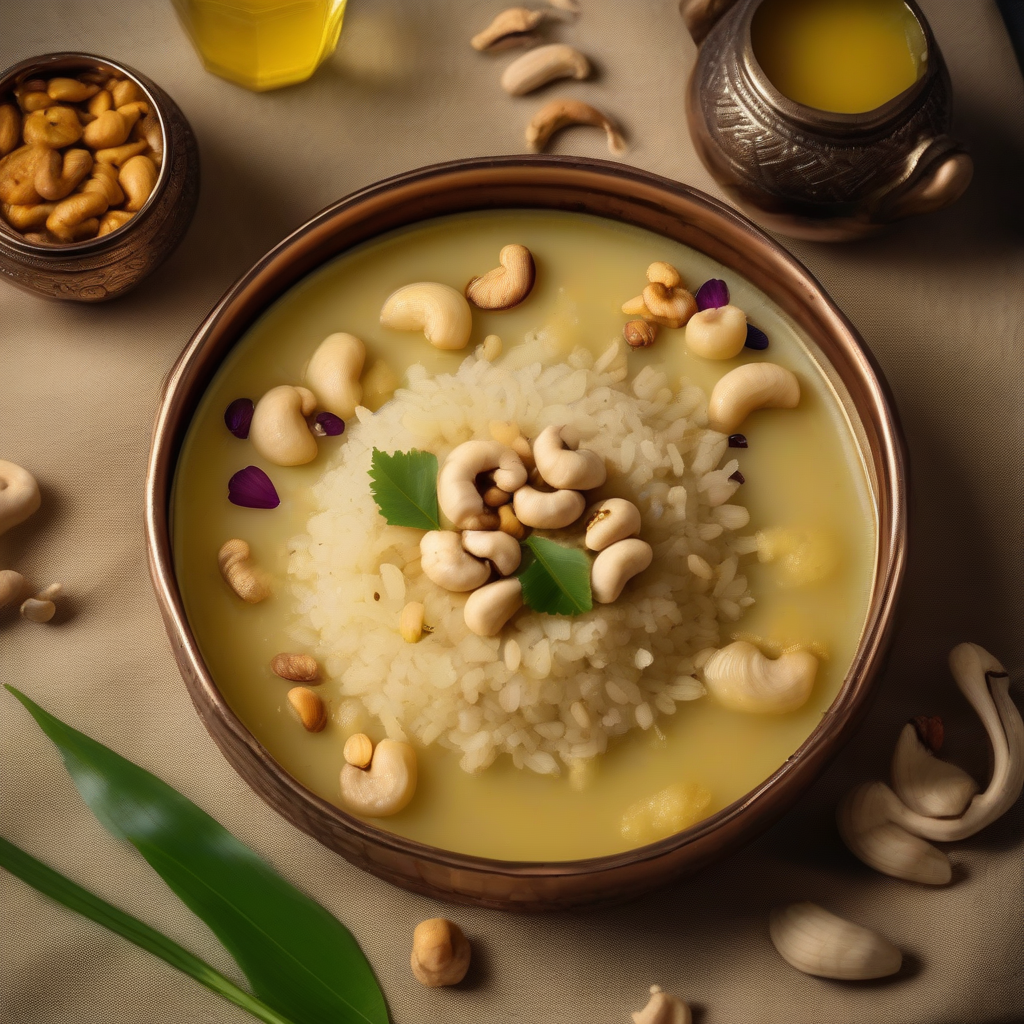Oye Hoye! Get Ready for a Divine Pongal Feast, Yaar!
Namaste and Vanakkam, my lovely food-loving friends! Chef Curry Do’pyaza here, back in your kitchens (virtually, of course!) with a dish that’s as heartwarming as a hug from your grandma. Today, we’re diving deep into the creamy, dreamy world of Sakkarai Pongal with Ghee and Cashews. This isn’t just a recipe; it’s a celebration on a plate!
When Pongal Pops Up!
Pongal isn’t just a dish; it’s an emotion! It’s most famously cooked during the Pongal harvest festival in Tamil Nadu, usually in mid-January. This vibrant festival celebrates the bounty of the harvest and gives thanks to the sun god, Surya. Think of it as India’s Thanksgiving, but with way more deliciousness! You’ll also find Pongal being whipped up during other auspicious occasions, family gatherings, and even as a sweet offering in temples. It’s a versatile dish that spreads joy wherever it goes!
A Sweet History Lesson
Pongal has a history as rich and golden as the ghee we’re about to use. Ancient texts mention a similar dish called “Ven Pongal,” which was a savory version. Over time, the sweet version, Sakkarai Pongal, evolved, becoming the star we know and love today. Imagine generations of families passing down this recipe, each adding their own little twist. It’s a culinary time capsule!
Let’s Get Cooking!
Preparation Time: 15 minutes
Cooking Time: 45 minutes
The Treasure Chest of Ingredients:
- Pacha Arisi (Raw Rice): 1 cup – Use a good quality short-grain rice for that authentic texture.
- Paasi Paruppu (Moong Dal): 1/4 cup – This adds a lovely creaminess.
- Vellam (Jaggery): 1 1/2 cups – The natural sweetness that makes Pongal, Pongal!
- Nei (Ghee): 1/2 cup (or more, because why not?) – The soul of this dish.
- Mundhiri (Cashews): 1/4 cup – Adds a delightful crunch.
- Kismis (Raisins): 2 tablespoons – For a burst of sweetness.
- Elakkai (Cardamom): 4-5 pods, crushed – The aromatic magic!
- Pachai Karpooram (Edible Camphor): A tiny pinch (optional) – Adds a unique fragrance, but be very careful with the quantity!
The Step-by-Step Symphony:
- Wash and Soak: Gently wash the rice and moong dal together. Soak them in water for about 15-20 minutes. This helps them cook evenly.
- Jaggery Syrup: In a saucepan, melt the jaggery with 1 cup of water over medium heat. Stir until the jaggery dissolves completely. Strain the syrup to remove any impurities. This gives you a smooth, clean sweetness.
- The Pressure Cooker Magic: In a pressure cooker, add the soaked rice and dal. Pour in the jaggery syrup and add 2 cups of water. Close the lid and cook for 3-4 whistles on medium heat. Let the pressure release naturally.
- Ghee-licious! Once the pressure is released, open the cooker. Mash the rice and dal mixture with a spoon or a masher until it’s smooth and creamy.
- The Grand Finale: In a separate pan, heat the ghee. Add the cashews and raisins and fry until the cashews turn golden brown and the raisins plump up.
- Aromatic Infusion: Add the crushed cardamom and the optional edible camphor to the ghee. Be quick, as the camphor can burn easily.
- Combine and Conquer: Pour the ghee mixture over the rice and dal mixture. Mix everything well until the ghee is fully incorporated and the Pongal is rich and glossy.
- Simmer and Serve: Simmer the Pongal on low heat for another 5-10 minutes, stirring occasionally, to allow the flavors to meld together beautifully.
Chef’s Secret Tips:
- Jaggery is Key: Use good quality jaggery for the best flavor. You can adjust the amount to your liking.
- Ghee is Gold: Don’t skimp on the ghee! It’s what makes this dish so decadent.
- Patience is a Virtue: Let the Pongal simmer on low heat to allow the flavors to develop fully.
Pongal Your Way: Cooking Mediums
- Gas Stove: Follow the pressure cooker method, or cook in a heavy-bottomed pot on low heat, stirring frequently.
- Induction Stove: Same as gas stove, adjust heat settings accordingly.
- Pressure Cooker: The quickest and easiest method, as described above.
- Slow Cooker/Crockpot: Cook on low for 4-6 hours, stirring occasionally.
- Microwave: Not recommended, as it’s difficult to control the cooking process.
- Oven/Air Fryer: Not applicable for this recipe.
Nutritional Nuggets:
Pongal is a good source of carbohydrates for energy, and the moong dal provides protein. Jaggery is a healthier alternative to refined sugar, and ghee adds healthy fats. However, it’s still a sweet dish, so enjoy it in moderation!
Serving Suggestions:
Serve Pongal hot, garnished with extra ghee and a sprinkle of chopped nuts. It pairs perfectly with a dollop of yogurt or a side of spicy sambar for a delightful contrast of flavors.
A Humble Request
So there you have it, my friends! A recipe for Sakkarai Pongal that’s guaranteed to bring a smile to your face. Try this recipe at home and share it with your friends and family. Let the aroma of ghee and cardamom fill your kitchen and your hearts! Happy cooking, and remember, food is love!
